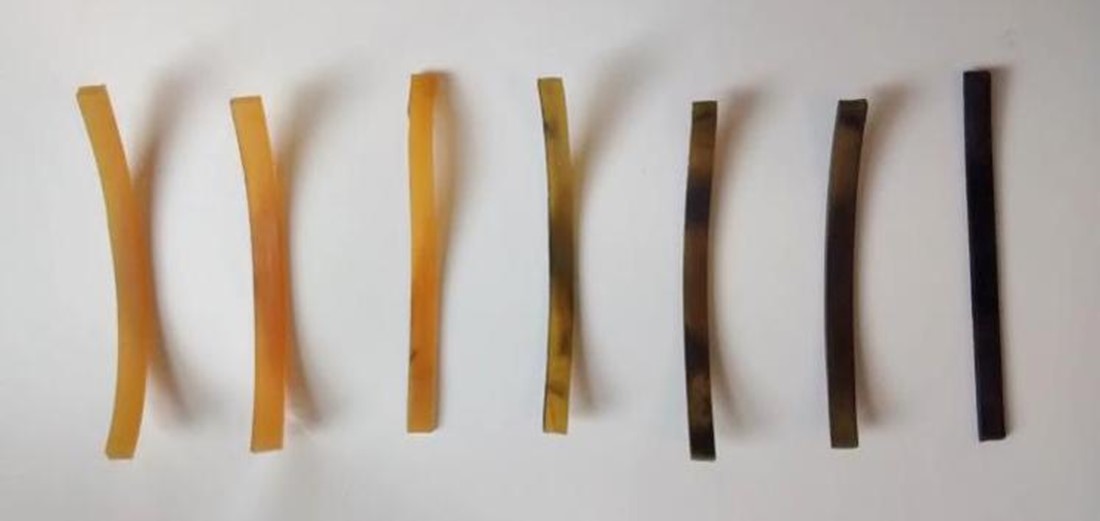Wearable motion sensors from graphene and rubber bands
Scientists in Ireland and the UK have combined the cutting edge material graphene with rubber bands to create wearable body motion sensors that can be used for monitoring joint and muscle motion, breathing and pulse.
This simple and innovative science will lead to cheap, mass-produced sensors for health monitoring and other applications. It is one of many examples of how the Graphene Flagship is taking this novel nanomaterial from the lab to the factory floor.
There is considerable interest in wearable electronics, including sensors for monitoring body motion, sleep patterns, heart rate and blood pressure. Much of the media and consumer attention concerns so-called smartwatches, but the market for wearable biosensors is far bigger than that. There are many and various applications for wearable sensors, and the need is for practical devices sensitive to mechanical strain at all levels from light breathing through to large scale joint articulation.
Strain sensors work by converting motion into electrical signals which can be measured and recorded, with the resistance of the sensor material changing with variations in the length of the material as it flexes in response to motion. Practical sensors must be produced cheaply and in large numbers, in various shapes, sizes and geometries. One example has sensing material incorporated into the fibres of garments.
Wearable biosensors have long been imagined, but the problem to date has been one of material performance. Silicon and metal-based electronics are rigid, yet flexibility is required for such applications. Nanomaterials such as hydrogels, treated papers, woven fibres infused with conducting materials, carbon nanotube arrays and other more complex nanostructures are under active consideration and development. So too is graphene, the two-dimensional material based on single atom-thick layers of carbon, with the atoms arranged in a honeycomb-like configuration.
Jonathan Coleman‘s chemical physics research group in Dublin, together with colleagues at the University of Surrey, have devised a way of creating wearable motion sensors by adding small amounts of graphene to the rubber bands which litter the desk drawers of office workers the world over. Professor Coleman’s group is part of AMBER (Advanced Materials and BioEngineering Research) – a Science Foundation Ireland-funded centre attached to Trinity College Dublin, and a key partner of the Graphene Flagship.

Rubber bands infused with graphene from solution under various conditions. The right-most specimen displays a uniform graphene dispersion.
The graphene-based motion sensor results are published in the leading nanoscience and technology journal ACS Nano, and the advance described in the study is down to the pioneering work of lead author Conor Boland, a third year research student nearing the end of his doctoral project. Boland’s paper describes a simple and innovative procedure for infusing graphene from solution into natural rubber, to create electrically conducting composite materials in which the performance is intimately linked with the material formation method.
Graphene offers a number of technical and economic advantages over other nanomaterials when used in strain sensors, says Coleman. “We expect them to be very cheap, and with sensors such as these, it is all about cost. Graphene-based strain sensors will be many times cheaper than those using carbon nanotubes.” Other materials such as carbon fibres might offer similar performance, but the fraction necessary would be several times that of the 0.5% of graphene infused into the Coleman group’s rubber bands. That said, the process described in the study is universal, and will allow for the infusion into rubber of nanomaterials other than graphene.
In the few weeks since the ACS Nano paper was published, there has been a huge amount of media interest in what is clearly a promising sensor fabrication technology with a number of technical, manufacturing and cost benefits. Many are asking Coleman about how he intends to develop on the work outlined in the scientific study. “We are talking with a number of companies,” he says. “Once we have decided on how best to proceed, we hope to enter into an industrial partnership co-funded by the Irish government, and together take the technology to the prototyping stage.”
As well as being a prolific scientist in his own right, Jonathan Coleman is deputy leader of the Materials work package of the Graphene Flagship: an academic-industrial initiative funded by the European Commission. The activities of the Graphene Flagship cover the entire value chain from materials science, engineering and production, through to components and system integration. The purpose of the Graphene Flagship is to facilitate the transfer of graphene from laboratory to factory floor, and accelerate the commercial exploitation of this remarkable material.
Graphene has the right electrical and mechanical properties required for wearable motion sensors, and the work by Coleman and his colleagues opens up a whole host of possibilities for biosensors made from rubber. Personal health monitoring is only one of a number of applications for such devices. Others include performance monitoring in athletes, automotive safety, and robotics.
Transforming the innovative chemical and applied physics process devised by Conor Boland into a working strain sensor will involve developing the electronics. The remaining challenges are those of engineering and manufacture.

Graphene-based strain sensors will be many times cheaper than those using carbon nanotubes.”
Deputy Leader WP3



